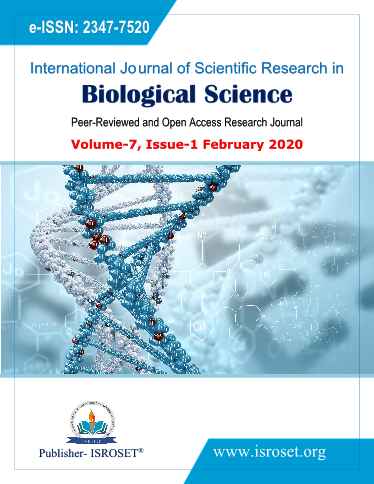Comparative Study on Cultivation of Oyster Mushrooms using Nutrition Enhancing Substrates
Keywords:
oyster mushroom, Pleurotus ostreatus, banana leaves, substrateAbstract
Mushrooms are heterotrophic organisms which require external nutritive substrates for their growth. This study compares the efficiency of different substrates (agricultural wastes such as oil cakes, bagasse, hay, saw dust, banana leaves etc.) on growth, yield and nutritional composition of oyster mushroom-Pleurotus ostreatus. Of the 14 different substrate combinations tried in this study, only 5 combinations successfully fruited with oyster mushrooms. The test substrates Hay (H), Sawdust (S), Hay + Banana leaves (H+BL, 1:1), Sawdust + Banana leaves (S+BL, 1:1), Hay + Sawdust + Banana leaves (H+S+BL, 1:1:1) gave good yield. Supplementation with banana leaves enhanced the yield of oyster mushrooms and protein content to a great extent. Protein content in oyster mushrooms from (H+S+BL) substrate was found to be 6.09g/100g, which was significant and considerably higher compared to other test substrates. There was also significant difference in the cropping period of mushrooms produced from 5 successful test substrates, ranging from a minimum of 26 days (H+BL) to a maximum of 46 days (H). Total yield produced by (S) and (H+S+BL) was higher than other substrates. The present study demonstrates that banana leaves are also efficient as a substrate along with conventional hay and sawdust. Apart from comparing various substrates on their efficiency, this study also has shown that available agricultural residues can be efficiently used for oyster mushroom cultivation as a cost effective and ecofriendly alternative. This study has demonstrated that minimum alternate substrate inputs can give high quality and good yield of oyster mushrooms.
References
V.Kumar, S.M.P. Chandra, S.C. Shancy, V.S. Shabnam, T.V. Lamya, “Cultivation of edible mushrooms in India: Precautions, Opportunities and Challenges”, Journal of Plant Development Sciences Vol.7, Issue. 5, pp. 409-413, 2015.
A.Z. Woldegiorgis, D. Abate, G.D. Haki, G.R. Ziegler, “Proximate and amino acid composition of wild and cultivated edible mushrooms collected from Ethiopia”, Journal of Food and Nutritional Science Vol. 3, Issue. 2, pp. 48-55, 2015.
A. Fekadu, “Cultivation of Shiitake mushroom, (Lentinus edodes) on coffee husk”, Journal of Food and Nutritional Sciences Vol. 3, Issue. 2, pp. 63-70, 2015.
W. Girma, T. Tasisa, “Application of Mushroom as Food and Medicine”, Adv Biotech & Micro. Vol. 11, Issue. 4, pp. 555817, 2018.
V.P. Sharma, S.K. Annepu, Y. Gautam, M. Singh, S. Kamal, “Status of mushroom production in India”, Mushroom Research Vol. 26, Issue 2, pp-111-120, 2017.
M. Shirur, N.S. Shivalingegowda, “Mushroom Marketing Channels and Consumer Behaviour: A Critical Analysis”, Mysore Journal of Agricultural Sciences Vol. 49, Issue. 2, pp. 390-393, 2015.
S.S. Patil, S.A. Ahmed, S.M. Telang, M.M. Baig, “The nutritional value of Pleurotus ostreatus (Jacq.:Fr) Kumm cultivated on different lignocellulosic agro-wastes”, Innov Rom Food Biotechnol Vol. 7, pp. 66-76, 2010
S.T. Chang, P.G. Miles, “Edible mushroom and their cultivation”, CRC Press, Boca Raton, FL, USA, 1989.
M.K. Biswas, “Microbial contaminants in Oyster mushroom (Pleurotus ostreatus) cultivation their management and role of meteorological factors”, Proceedings of 8th International Conference on Mushroom Biology and Mushroom Products, New Delhi, pp. 1-10, 2014.
D.R. Sonali, “Cultivation and study of growth of oyster mushroom on different agricultural waste substrate and its nutritional analysis”, Advances in Applied Research Vol. 3, Issue. 4, pp. 1938-1949, 2012.
G.H. Adebayo, B.N. Omolara, A.E. Toyin, “Evaluation of yield of oyster mushroom (Pleurotus pulmonarius) grown on cotton waste and cassava peel”, African Journal of Biotechnology, Vol. 8, Issue. 2, pp. 215-218, 2009.
J. Ashraf, M.A. Ali , W.Ahmad, C.M. Ayyub, J.Shafi J, “Effect of different substrate supplements on oyster mushroom (Pleurotus spp.) production”, Food Science and Technology, Vol. 1, Issue. 3, pp. 44-51, 2013.
V.J. Tirkey, S. Simon, A.A. Lal, “Efficacy of different substrates on the growth, yield and nutritional composition of oyster mushroom- Pleurotus florida (Mont.) Singer”, Journal of Pharmacognosy and Phytochemistry, Vol. 6, Issue. 4, pp. 1097-1100, 2017.
E. Baysal, H. Perker, M. Kemal, A. Temiz, “Cultivation of oyster mushroom on waste paper with some added supplementary materials”, Bioresource technology, Vol. 89, pp. 95-97, 2003.
D.B. Tarko, A.M. Sirna, “Substrate optimization for cultivation of Pleurotus ostreatus on lignocellulosic wastes (coffee, sawdust, and sugarcane bagasse)”, Journal of Applied Biology & Biotechnology, Vol. 6, Issue. 4, pp. 14-20, 2018.
Z. Shah, M. Ashraf, M. Ishtiaq, “Comparative study on cultivation and yield performance of oyster mushroom (Pleurotus ostreatus) on different substrates (Wheat Straw, Leaves, Saw Dust)”, Pakistan Journal of Nutrition Vol. 3, Issue. 3, pp. 158-160, 2004.
Downloads
Published
How to Cite
Issue
Section
License

This work is licensed under a Creative Commons Attribution 4.0 International License.
Authors contributing to this journal agree to publish their articles under the Creative Commons Attribution 4.0 International License, allowing third parties to share their work (copy, distribute, transmit) and to adapt it, under the condition that the authors are given credit and that in the event of reuse or distribution, the terms of this license are made clear.







